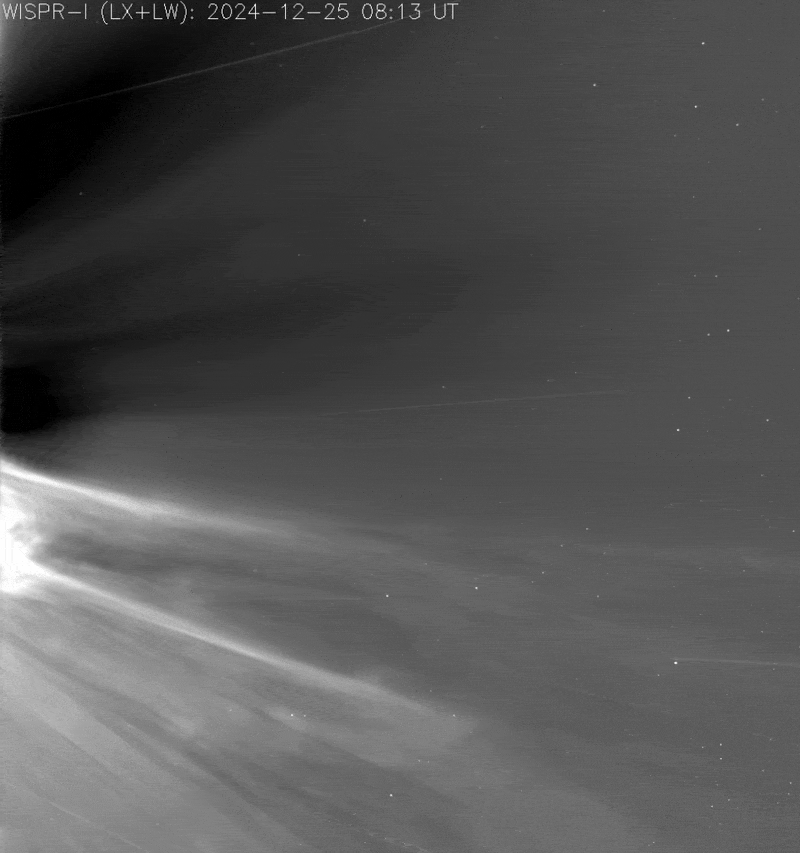NASA had a special Christmas gift last year. On December 24, the Parker Solar Probe reached the closest it will ever get to the Sun. As it flew just 6.1 million kilometers (3.8 million miles) from its surface, it snapped a picture of the solar wind, the stream of particles that is released from the Sun, which can travel at a speed of over 1.6 million kilometers (1 million miles) per hour.
You might be wondering why the picture is not of the surface of the Sun. Why get so close without photographing the surface? That’s because it would literally cook the spacecraft. Parker was designed with a shield that can withstand the over 1,000 degree temperatures of the solar corona at that distance from the Sun, but its internal temperature is a cosy 29°C (85°F). A camera directed at the Sun, even with filters, would let in so much light that it would heat up the instruments.

Parker Solar Probe’s WISPR instrument snapped these images during the record-breaking flyby of the Sun on December 25, 2024, showing the solar wind racing out from the Sun’s outer atmosphere, the corona.
Image credit: NASA/Johns Hopkins APL/Naval Research Lab
This “touching the Sun” the spacecraft does every perihelion – the point of closest approach with the Sun – with its various instruments measuring particles and magnetic fields escaping the Sun. Among them, there is WISPR (Wide-field Imager for Solar Probe), which snaps images of the solar wind escaping.
“Parker Solar Probe has once again transported us into the dynamic atmosphere of our closest star,” Nicky Fox, associate administrator, Science Mission Directorate at NASA Headquarters in Washington, said in a statement. “We are witnessing where space weather threats to Earth begin, with our eyes, not just with models. This new data will help us vastly improve our space weather predictions to ensure the safety of our astronauts and the protection of our technology here on Earth and throughout the Solar System.”
There are many unknowns when it comes to the solar wind. Some of it is fast, but there is a denser, slower version, traveling at about half its usual speed (350 kilometers per hour or 220 miles per hour). The work of the solar probe is about delivering new insights into it.
“The big unknown has been: how is the solar wind generated, and how does it manage to escape the Sun’s immense gravitational pull?” said Nour Rawafi, the project scientist for Parker Solar Probe at the Johns Hopkins Applied Physics Laboratory. “Understanding this continuous flow of particles, particularly the slow solar wind, is a major challenge, especially given the diversity in the properties of these streams — but with Parker Solar Probe, we’re closer than ever to uncovering their origins and how they evolve.”
Parker has conducted two more close passages to the Sun on March 22 and June 19. Its next ones are September 15 and December 12. The close passage and incredible gravitational pull of the Sun have made Parker the fastest human-made object in the cosmos.
The mission will continue until the thrusters have fuel (or until the Trump administration cancels it like so many others). At that point, the craft will rotate so that the instruments are exposed to the full radiance of the Sun, which would rip them apart. But not the heat shield – that will survive for millions of years in its orbit around the Sun.
Source Link: NASA Releases Closest Ever Images Of The Sun, Snapped As Probe Travels Through Its Atmosphere